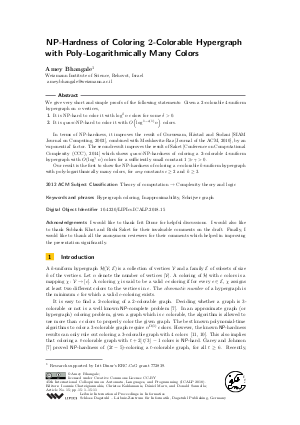NP-Hardness of Coloring 2-Colorable Hypergraph with Poly-Logarithmically Many Colors
Author Amey Bhangale
-
Part of:
Volume:
45th International Colloquium on Automata, Languages, and Programming (ICALP 2018)
Part of: Series: Leibniz International Proceedings in Informatics (LIPIcs)
Part of: Conference: International Colloquium on Automata, Languages, and Programming (ICALP) - License:
 Creative Commons Attribution 3.0 Unported license
Creative Commons Attribution 3.0 Unported license
- Publication Date: 2018-07-04
File

PDF
LIPIcs.ICALP.2018.15.pdf
- Filesize: 0.54 MB
- 11 pages
Document Identifiers
Subject Classification
ACM Subject Classification
- Theory of computation → Complexity theory and logic
Keywords
- Hypergraph coloring
- Inapproximability
- Schrijver graph
Metrics
- Access Statistics
-
Total Accesses (updated on a weekly basis)
0Document
0Metadata
Abstract
We give very short and simple proofs of the following statements: Given a 2-colorable 4-uniform hypergraph on n vertices,
1) It is NP-hard to color it with log^delta n colors for some delta>0.
2) It is quasi-NP-hard to color it with O({log^{1-o(1)} n}) colors.
In terms of NP-hardness, it improves the result of Guruswam, Håstad and Sudani [SIAM Journal on Computing, 2002], combined with Moshkovitz-Raz [Journal of the ACM, 2010], by an `exponential' factor. The second result improves the result of Saket [Conference on Computational Complexity (CCC), 2014] which shows quasi-NP-hardness of coloring a 2-colorable 4-uniform hypergraph with O(log^gamma n) colors for a sufficiently small constant 1 >> gamma>0.
Our result is the first to show the NP-hardness of coloring a c-colorable k-uniform hypergraph with poly-logarithmically many colors, for any constants c >= 2 and k >= 3.
Cite As Get BibTex
Amey Bhangale. NP-Hardness of Coloring 2-Colorable Hypergraph with Poly-Logarithmically Many Colors. In 45th International Colloquium on Automata, Languages, and Programming (ICALP 2018). Leibniz International Proceedings in Informatics (LIPIcs), Volume 107, pp. 15:1-15:11, Schloss Dagstuhl – Leibniz-Zentrum für Informatik (2018)
https://doi.org/10.4230/LIPIcs.ICALP.2018.15
BibTex
@InProceedings{bhangale:LIPIcs.ICALP.2018.15,
author = {Bhangale, Amey},
title = {{NP-Hardness of Coloring 2-Colorable Hypergraph with Poly-Logarithmically Many Colors}},
booktitle = {45th International Colloquium on Automata, Languages, and Programming (ICALP 2018)},
pages = {15:1--15:11},
series = {Leibniz International Proceedings in Informatics (LIPIcs)},
ISBN = {978-3-95977-076-7},
ISSN = {1868-8969},
year = {2018},
volume = {107},
editor = {Chatzigiannakis, Ioannis and Kaklamanis, Christos and Marx, D\'{a}niel and Sannella, Donald},
publisher = {Schloss Dagstuhl -- Leibniz-Zentrum f{\"u}r Informatik},
address = {Dagstuhl, Germany},
URL = {https://drops.dagstuhl.de/entities/document/10.4230/LIPIcs.ICALP.2018.15},
URN = {urn:nbn:de:0030-drops-90190},
doi = {10.4230/LIPIcs.ICALP.2018.15},
annote = {Keywords: Hypergraph coloring, Inapproximability, Schrijver graph}
}
Author Details
Funding
- Bhangale, Amey: Research supported by Irit Dinur’s ERC-CoG grant 772839.
References
- Sanjeev Arora, Carsten Lund, Rajeev Motwani, Madhu Sudan, and Mario Szegedy. Proof Verification and the Hardness of Approximation Problems. J. ACM, 45(3):501-555, 1998. (Preliminary version in 33rd FOCS, 1992). URL: http://dx.doi.org/10.1145/278298.278306.
-
Sanjeev Arora and Shmuel Safra. Probabilistic Checking of Proofs: A new characterization of NP. JACM, 45(1):70-122, 1998. (Preliminary version in 33rd FOCS, 1992).

-
J Bárány. A short proof of Kneser’s conjecture. Journal of Combinatorial Theory, Series A, 25(3):325-326, 1978.

-
Joshua Brakensiek and Venkatesan Guruswami. New hardness results for graph and hypergraph colorings. In LIPIcs-Leibniz International Proceedings in Informatics, volume 50. Schloss Dagstuhl-Leibniz-Zentrum fuer Informatik, 2016.

-
I Dinur, O Regev, and C Smyth. The hardness of 3-uniform hypergraph coloring. In Foundations of Computer Science, 2002. Proceedings. The 43rd Annual IEEE Symposium on, pages 33-40. IEEE, 2002.

-
Uriel Feige, Shafi Goldwasser, Laszlo Lovász, Shmuel Safra, and Mario Szegedy. Interactive proofs and the hardness of approximating cliques. Journal of the ACM (JACM), 43(2):268-292, 1996.

-
Michael R Garey and David S Johnson. The complexity of near-optimal graph coloring. Journal of the ACM (JACM), 23(1):43-49, 1976.

-
Venkatesan Guruswami, Prahladh Harsha, Johan Håstad, Srikanth Srinivasan, and Girish Varma. Super-polylogarithmic Hypergraph Coloring Hardness via Low-degree Long Codes. In Proceedings of the Forty-sixth Annual ACM Symposium on Theory of Computing, STOC '14, pages 614-623, New York, NY, USA, 2014. ACM.

-
Venkatesan Guruswami, Johan Håstad, and Madhu Sudan. Hardness of approximate hypergraph coloring. SIAM Journal on Computing, 31(6):1663-1686, 2002.

-
Venkatesan Guruswami and Sanjeev Khanna. On the hardness of 4-coloring a 3-colorable graph. SIAM Journal on Discrete Mathematics, 18(1):30-40, 2004.

-
Sanjeev Khanna, Nathan Linial, and Shmuel Safra. On the hardness of approximating the chromatic number. In Theory and Computing Systems, 1993., Proceedings of the 2nd Israel Symposium on the, pages 250-260. IEEE, 1993.

-
Subhash Khot. Hardness results for approximate hypergraph coloring. In Proceedings of the thiry-fourth annual ACM symposium on Theory of computing, pages 351-359. ACM, 2002.

-
Subhash Khot. Hardness results for coloring 3-colorable 3-uniform hypergraphs. In Foundations of Computer Science, 2002. Proceedings. The 43rd Annual IEEE Symposium on, pages 23-32. IEEE, 2002.

-
Subhash Khot and Rishi Saket. Hardness of Coloring 2-Colorable 12-Uniform Hypergraphs with exp (log^Omega (1) n) Colors. In Foundations of Computer Science (FOCS), 2014 IEEE 55th Annual Symposium on, pages 206-215. IEEE, 2014.

-
Subhash Khot and Rishi Saket. Hardness of finding independent sets in 2-colorable and almost 2-colorable hypergraphs. In Proceedings of the twenty-fifth annual ACM-SIAM symposium on Discrete algorithms, pages 1607-1625. SIAM, 2014.

-
László Lovász. Kneser’s conjecture, chromatic number, and homotopy. Journal of Combinatorial Theory, Series A, 25(3):319-324, 1978.

-
Dana Moshkovitz and Ran Raz. Two-query PCP with subconstant error. Journal of the ACM (JACM), 57(5):29, 2010.

-
Ran Raz. A parallel repetition theorem. SIAM Journal on Computing, 27(3):763-803, 1998.

-
Rishi Saket. Hardness of finding independent sets in 2-colorable hypergraphs and of satisfiable CSPs. In IEEE 29th Conference on Computational Complexity (CCC), pages 78-89, 2014.

-
A Schrijver. Vertex-critical subgraphs of Kneser-graphs. Nieuw Archief voor Wiskunde, 26:454-461, 1978.

-
Girish Varma. Reducing uniformity in Khot-Saket hypergraph coloring hardness reductions. Chicago Journal OF Theoretical Computer Science, 3:1-8, 2015.

